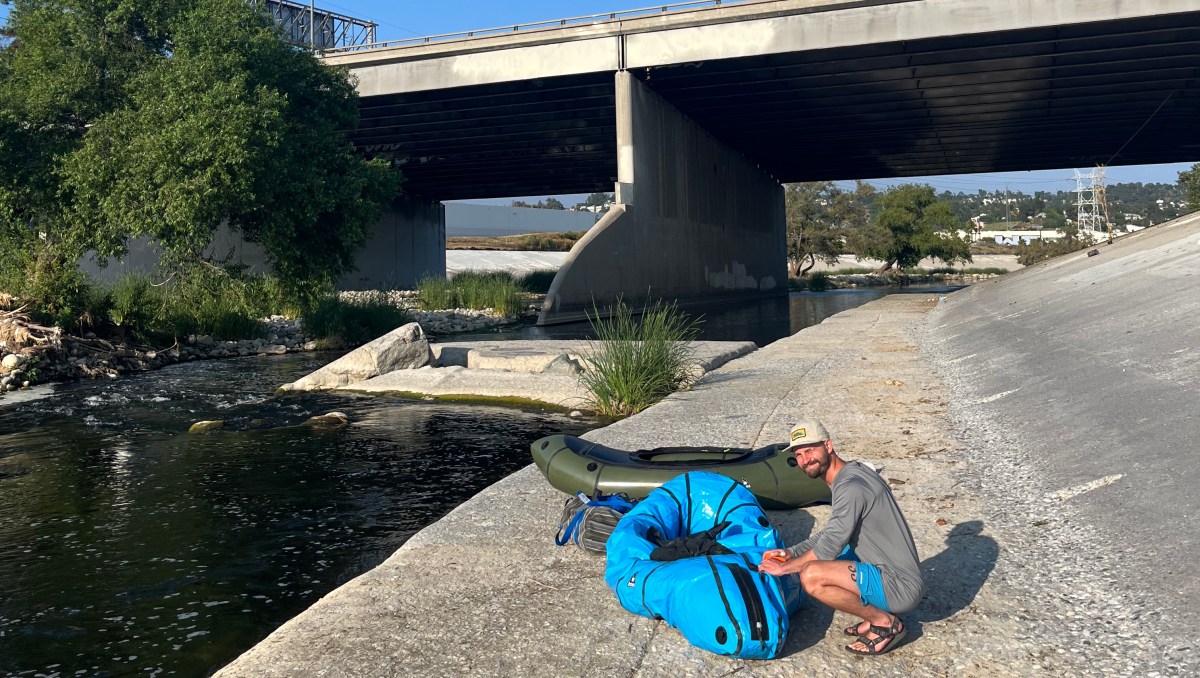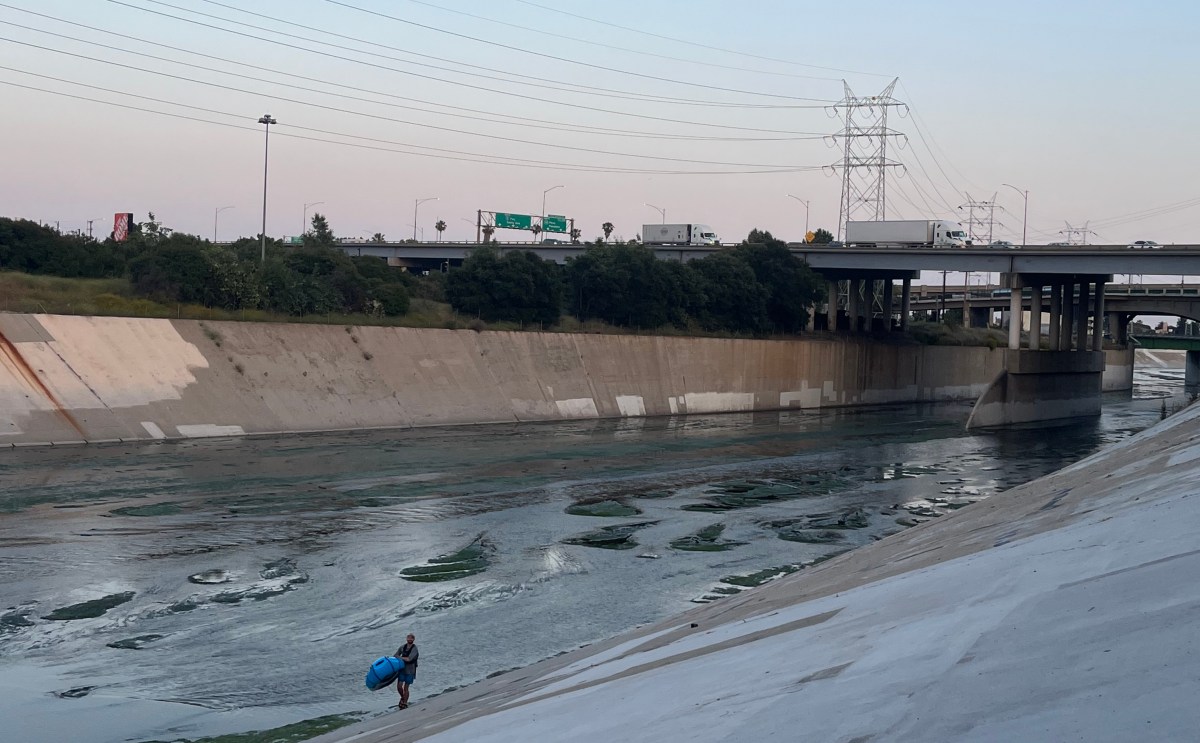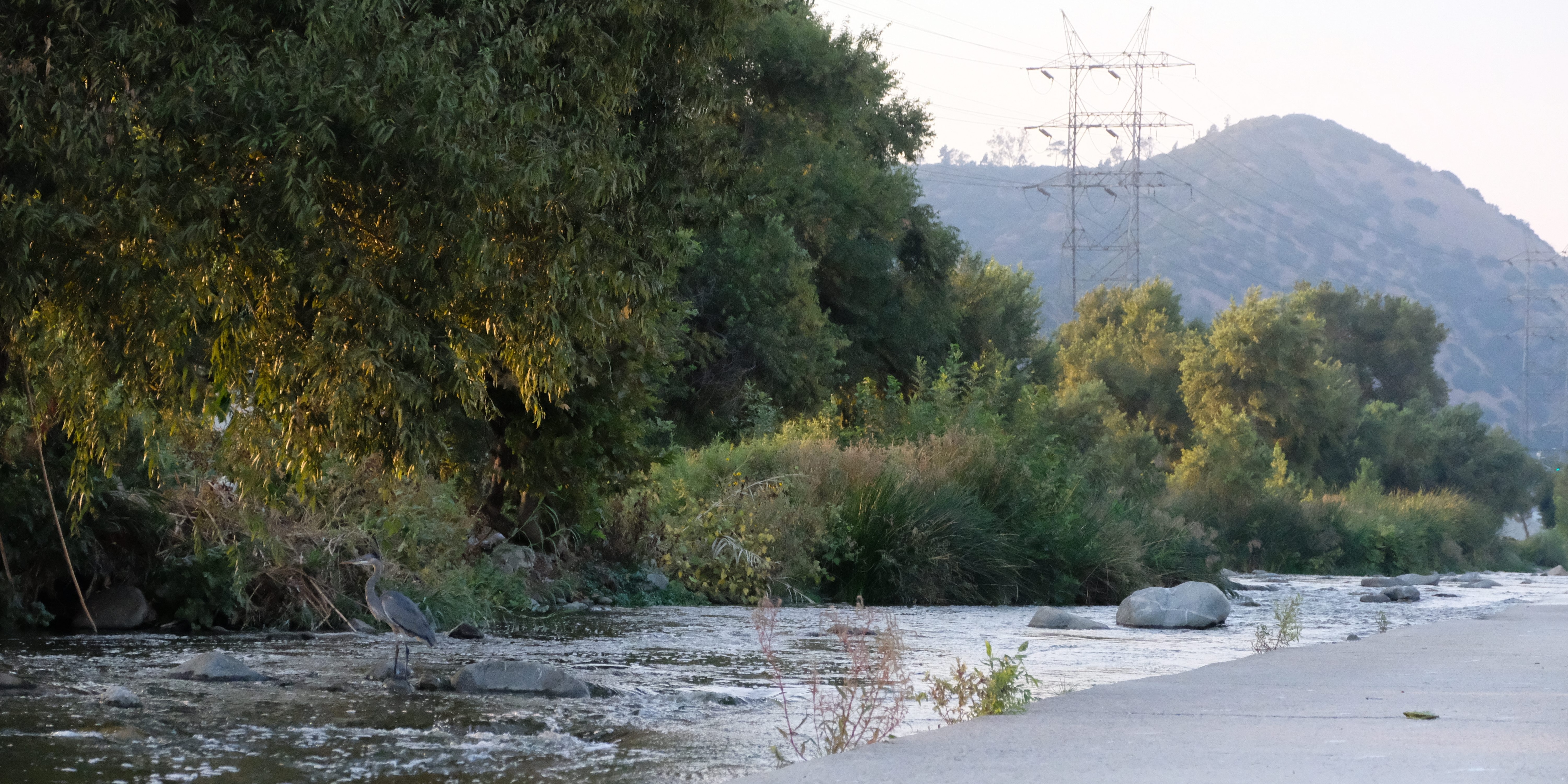As the stilts first started dive-bombing us on the water, I couldn’t help but wonder why ornithologists had named them “black-necked” when the nape was the bird’s least telling feature.
I was taken by an up-close view of one’s hot pink, pipe cleaner legs as it swooped at my partner and me. Hot pink stilts, I thought as I ducked and dodged the attack from the water. Now that’s a better name.
We’d unintentionally come too close to the flocks’ camouflaged nests during our paddle down the Los Angeles River, resulting in a cacophony of high-pitched KEEKs and numerous close calls to our ball caps. The water birds flitted above aggressively as we paddled away from their tiny chicks. In all my years of observing stilts on the river, I’d never feared them. But there I was, dodging the elegant creatures with dangerous legs.
Since moving to Los Angeles from Colorado in 2016, the river has been a lifeline for me. I’ve spent much of my free time on its concrete banks—walking, birding, biking, and even fly fishing for carp and invasive Amazon sunfish. My first time paddling the river deepened my love for the 52-mile stretch of water even further.
The LA river—called Paayme Paxaayt, or “west river,” by the Tongva people—is an accessible slice of wilderness for many in the park-poor city. A few “soft bottomed” sections of the river are popular for their natural beauty and recreation opportunities. Candice Dickens-Russell, CEO of Friends of the Los Angeles River, an REI Cooperative Action Fund grantee, explained that there are three of these sections along the river and they draw a wealth of nature—as well as recreationalists who enjoy it.
One of these popular locales is known as the Glendale Narrows. Its bottom wasn’t paved because of the rising water table, so cottonwood, alder and willow trees sprout from it, turning the sliver of wilderness green. Nineteen species of bats and over 200 species of birds have been found on the river, many in these natural channels.
“Los Angeles is a biodiversity hot spot,” Dickens-Russell says, explaining that while the city is a heavily built environment, the region has a wealth of flora and fauna. Her organization aims to build connections between Angelinos and the river, introducing them to the plants and animals. “The river itself acts as a park and a green space for all of the families who don’t have access to green spaces,” she says.

During the earlier years of the COVID-19 pandemic, the river became an even more important place for me. Not only was it somewhere I could go for walks, but I spent time getting to know communities who relied on the river for sustenance and shelter, as I reported about unhoused anglers who lived on or near the river and fish for sustenance. I developed a closer understanding of the river and its role not just as a place for recreation, but as a home for thousands of Angelinos.
From the unhoused anglers, and others I met on my walks on the river, I heard of past brave paddlers who made homemade rafts and rode the river when it flooded, carrying them downstream in a deadly torrent of water. Those stories, and my years of whitewater kayaking and paddling out west, made me dream of floating the Los Angeles River’s curve one day, from its northern source in the Santa Susana Mountains in the western San Fernando Valley, to its mouth farther south in San Pedro Bay. Unfortunately, due to logistics, varying water levels and bureaucratic red tape, that journey is no longer possible.
However, two sections of the LA River Recreation Zone are open for paddling every year, from Memorial Day through late September. One had always been on my bucket list.
When May of 2023 rolled around and the Elysian Valley zone opened, my partner, Aaron, and I shuttled cars in the Frogtown neighborhood between our put-in and drop-off points. Soon, we were pumping air into our packrafts on a slab of concrete below the Fletcher Drive Bridge, photosynthesizing in the warm spring air to a frog chorus.
Besides groups hosted by the guide companies LA River Kayak Safari and LA River Expeditions, it’s fairly uncommon to see paddlers on the river. Cyclists and roller skaters on the adjacent bike path gawked at us as we took on the first ripple, an easy roller and splashy welcome to the 3-mile float.
What Is Packrafting?
A combination of backpacking and rafting, packrafting allows you to explore bodies of water while camping along the way. An inflatable raft makes it easier to travel by both land and water during the journey.
Read more: Packrafting Basics
We drifted below the bridge listening to a cacophonous buzz: a mix of dragonflies, the nearby Interstate 5 in rush-hour traffic and towering electrical wires. I know this buzz—one of the Friends of the Los Angeles River founders, Lewis MacAdams, described it in a poem chronicling his early, fence-cutting exploits on the river and how he and many others fought to make it accessible to Angelinos. Because of these and many other environmental stewards, the Glendale Narrows buzzed, and hummed and chirped on our float.
Being back on the water felt incredible. I grew up whitewater kayaking on desert rivers, sharpening my skills in college through Colorado’s Royal Gorge and Utah’s Westwater Canyon. But, the pandemic had changed me from a thrill seeker to just grateful to be here after I became disabled with long COVID-19.
Watersports, it turned out, had become a more accessible hobby for me as my other loves of mountain climbing, running and rock climbing were no longer possible with my autonomic dysfunction and post-exertional malaise (PEM) from my disease. On the river, I can let gravity take me without expending much energy or raising my heart rate.

The river’s slow was mesmerizing—it took our green and electric-blue rafts down its course as we heard a roller skater’s speaker blasting Bad Bunny down river. We stared up in awe at the impressive cottonwoods. We could see the river’s swell and violence from the winter’s rains; clothes and natural debris wrapped around their trunks, 15 feet high.
It was a reminder of the power of the river before it was squeezed in its concrete straightjacket, beginning in the late 1930s. The river would cause fatal floods and change its course across wide floodplains. I imagined these plains as we paddled farther down the river. What did the silver shimmer of spawning steelhead trout look like in the Southern California sun? What did grizzly bear paws sound like splashing on the shore? Or a cub’s snore, passed out with a full belly on a bank of California poppies?
A nearby great blue heron’s velociraptorlike squawk took me out of my daydream. Aaron pointed to the bird with his paddle’s tip, water dripping off of it like diamonds in the late day light. At first, the heron waded on its long legs, waiting for its prey; but as we passed, the bird erupted into flight. We traced its flightpath until we noticed a split in the river’s channel. When we arrived at the juncture, we took the deeper channel and heard the rushing sound of whitewater.
The Call of the Great Blue Heron
It’s hard to miss a great blue heron sighting at the LA River. According to Kimball Garrett, ornithology collections manager at the Natural History Museum of Los Angeles County, they are one of the river’s most noticeable bird spieces.1
The small channel took us through the leafy trees and series of small ripples leading to a significant drop. The falls were much steeper than I expected—they tumbled down a few feet of rocks with the satisfying whoosh of whitewater. The obstacle could certainly flip a boat and toss a paddler into the river’s depths. We certainly wanted to avoid going for a swim.
I knew to safely navigate it would require a “boof”, a technique where you take a strong paddle stroke to get momentum to clear the drop and land safely on the water below. I angled my boat toward the steepest part of the drop and rode the ripples like a bucking bronco. I could smell the river’s earthy coolness as I approached the drop; the cascading water misted into the air. I was nervous and thought for sure I would flip.
3, 2, 1, boof!
I launched into the air and plunged into the water below me, letting out a big yeehaw! I took a large sweep stroke to turn my packraft so I could watch Aaron tackle the obstacle. Despite never going over a drop that big in a boat, he cleared it like an expert.
“We just boofed on the LA River!” I yelled.
Our victory was short-lived. After paddling for a half-mile, we hit a shallow section and had to drag our rafts as rocks prevented us from moving forward. Then, we saw the stilts.
They dove, screeched, swooped, rattled and flapped above us as we paddled away, another reminder that the river is a much-needed home for so many animals. Other camera traps have caught coyotes, raccoons, foxes, even cougars crossing its waters. With the river deepening ahead of us, we cruised down its course as the sound of the current and wind threading through the cattails lining the river overtook the stilts’ KEEKs. We passed under the bright orange Taylor Yard Bridge as swifts boomeranged for bugs, and we rode small ripples until we reached my favorite part of the Recreation Zone.

The channel narrowed and enormous cattails and grasses rocketed into the sky on either side. Here, you could barely even hear the highway or the nearby high wires’ buzz. It was like paddling on Costa Rica’s Pacuare River, if only for a few hundred yards. Of course, replace Costa Rica’s toucans with black-crowned night herons and red whiskered bulbuls.
Soon, the Narrows’ soft bottom gave way to the concrete and the river widened across the pavement. We stepped out of our rafts and carried them up the steep slope to our car. At the top, we could see the river flowing slowly toward downtown Los Angeles under a spiderweb of interstates.
The river’s sound and current were no longer audible, drowned out by the whoosh of cars. Like any river trip, by the time we drove back to our starting point to get our other car, we were ready to do it all over again. The pull of the river is fierce.
- Jao, Carren. “The Los Angeles River, a Surprising Oasis for Birds.” PBS SoCal, 29 Mar. 2024, www.pbssocal.org/shows/earth-focus/the-los-angeles-river-a-surprising-oasis-for-birds. ↩︎
